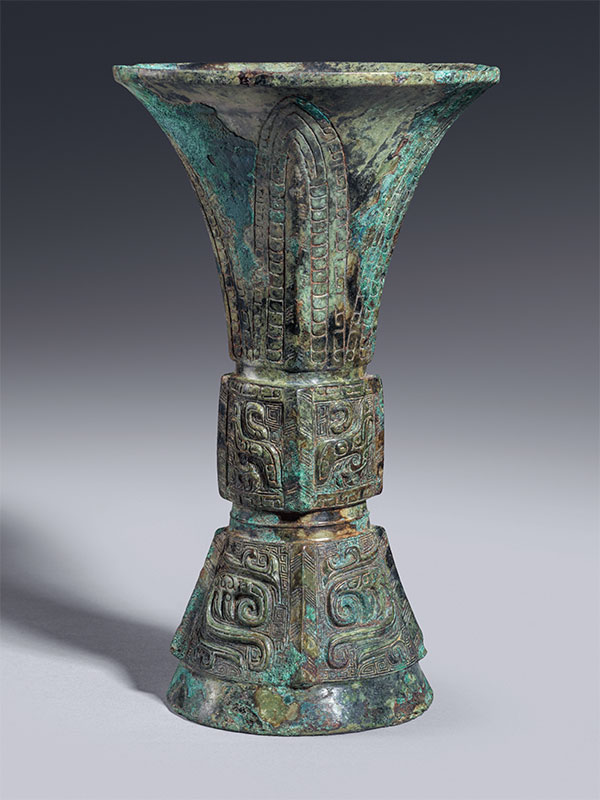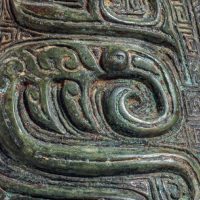Bronze ritual beaker, Gu
China, late Shang dynasty, Anyang phase, 12th – 11th century BC
An archaic bronze beaker with flared base section and tall neck, which gradually widens to a trumpet mouth. The body is divided into three horizontal sections; each section has four raised ridges of triangular section, which are lightly engraved with slanted lines, forming a chevron pattern. The lower and middle sections are divided into four panels of paired rudimentary dragons on a ground of spirals. The dragons, when viewed in pairs, form large taotie masks with prominent, bulging eyes. The top section is decorated with four vertical leaf ornaments. The metal is partly covered in an attractive malachite patina.
Together with the tripod pouring vessel, jue, the slender chalice-like beaker known as gu is one of the oldest forms in the repertory of archaic bronze vessels. The term gu was given to this type of beaker in the Song dynasty (960 – 1279 AD), it does not appear in ancient texts. This type of gu with raised ridges engraved with a chevron pattern is unusual – most gu beakers have sharp-edged, notched flanges – and is usually given a late Anyang date; according to Bagley ‘Ridges with these distinctive stripes do not seem to occur before the last two Anyang reigns.’[1] The stout shape differs from the tall and slender gu that occur more frequently, and demonstrates the innovative capability of late Anyang bronze casters. Several similar gu are published: the most closely related example is a gu found in 1977 in the Yingxu West Sector at Anyang in a grave assigned to the last quarter of the Anyang period.[2] Two further gu with slightly different decoration to the middle section are in the British Museum, London[3] and in the Palace Museum, Beijing.[4] A zun in the Freer Gallery of Art, Washington has similar triangular ridges with chevron pattern.[5]
Provenance:
Ben Janssens Oriental Art, January 2005
Private Collection, UK
- Bagley, R.W. Shang Ritual Bronzes in the Arthur M. Sackler Collections, Cambridge, Mass. 1987, p. 304
- op. cit. fig. 49.27, p. 306
- op. cit. fig. 49.29, p. 306
- Liu Yu and Ding Meng Bronzes in the Palace Museum, Palace Museum Publications, Beijing 1999, no. 42, p.69
- Pope, J.A. et al. The Freer Chinese Bronzes Vol. I, Catalogue, Smithsonian Institution, Freer Gallery of Art, Washington, 1967, no. 13, pp. 84-5


